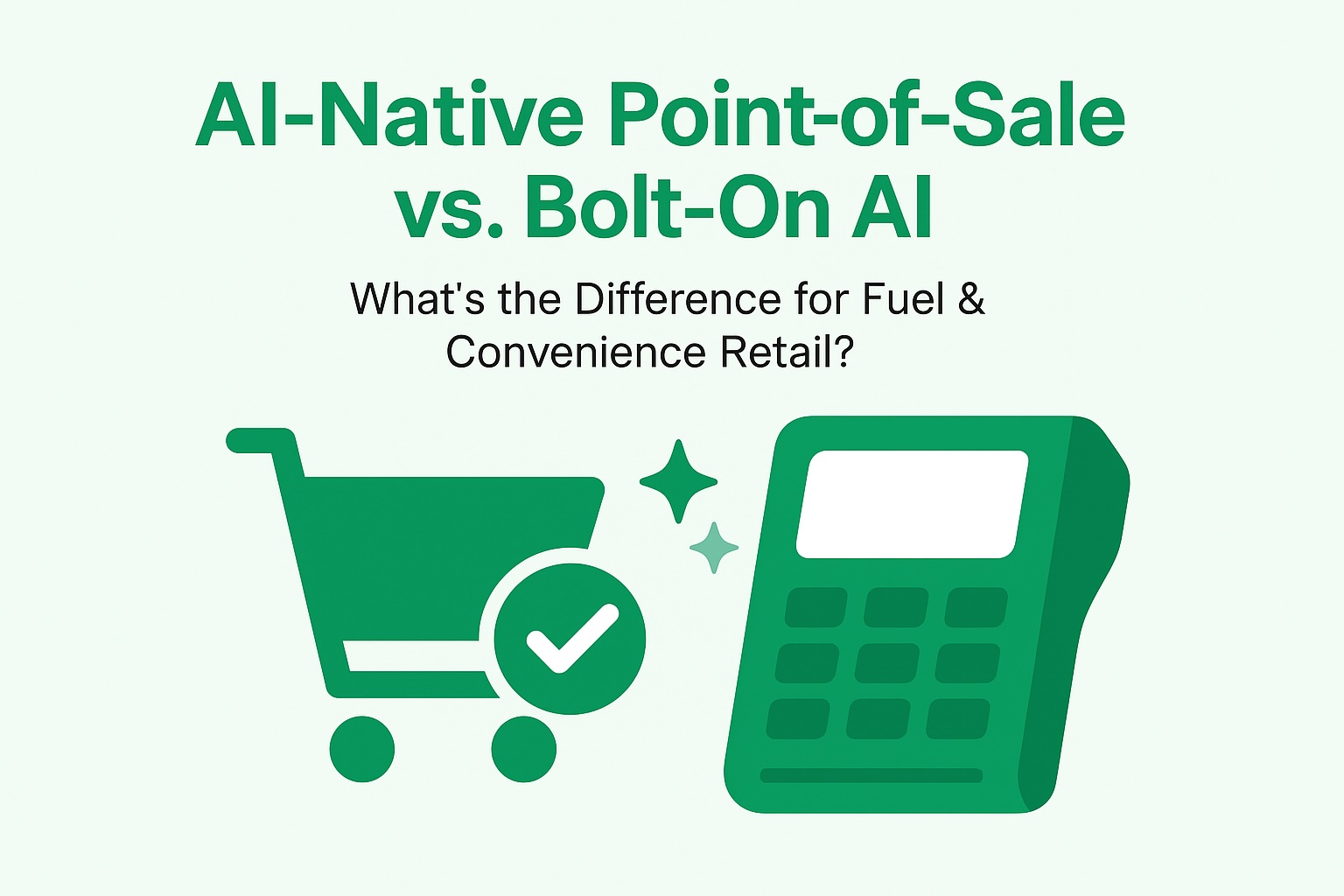When every point-of-sale (POS) vendor claims to be "AI-powered," how do you separate real innovation from marketing spin?
As retailers evaluate POS systems, AI has become the buzzword du jour. But there's a massive difference between AI that's bolted onto legacy systems and AI that's built into the platform foundation. The distinction isn't academic. It determines whether AI actually transforms your operations or just gives you an expensive chatbot.
Let me explain what separates the two approaches and why it matters for your business.
Bolt-On AI Defined
Bolt-on AI happens when legacy POS vendors try to retrofit AI to their older software with mounds of tech debt. It’s like fitting a modern, high-performance engine to a fifty-year-old drivetrain and chassis and expecting it to perform at a world-class level. It’s slapping a chatbot onto decades-old architecture and calling it innovation. The AI might look intelligent in a demo, but it can't fundamentally change how the platform works.
Here's the reality: if you removed the AI layer, you'd collapse back into the same legacy workflows you've always had. The AI is cosmetic, not structural.
These bolt-on solutions typically offer:
- A single assistant that searches static documentation
- Limited integration with actual system data
- No ability to take actions or complete workflows
- Answers that ignore your specific configuration and setup
The problem runs deeper than functionality. Bolt-on AI can't evolve with your business because it sits on top of inflexible architecture. When AI advances (and it will), you're stuck waiting for your vendor to catch up.
AI-Native Defined
At Tote.ai, we built AI into our data architecture and platform foundation from day one. A high-tuned engine, drivetrain, and chassis acting in concert to deliver world-class performance. We’re the first and only vendor providing this, so I’ll run you through how it works. Our AI agents are integrated from the ground up (not an afterthought).
The AI-native difference shows up in three critical ways:
1. AI-Native Works With Live System Data
Because it’s native, our AI doesn't just search static knowledge bases. It queries real-time data about pump status, inventory levels, transaction history, and system configuration. When an associate asks for help, the AI understands the store’s bigger contextual picture and provides customized, actionable guidance based on that store’s specific setup.
This matters because no two stores operate exactly the same way. Your promotions, your policies, your hardware configuration are unique. AI that can't see this context can't really help you.
2. AI-Native Can Take Action & Fix Things
True AI-native systems allow agents to do more than retrieve information. Our agents can restart devices, trigger workflows, and complete tasks through the same APIs the platform uses. When something goes wrong, AI doesn't just tell you about it. It can often fix it.
This capability transforms support operations. Instead of escalating every issue to IT, associates get immediate resolution for common problems. We're seeing clients automate 80-90% of support tickets this way.
3. AI-Native is Future-Proof, Enabling Multi-Agent Collaboration
We designed Tote.ai to be future-proof, ready for an ecosystem of specialized agents, not just one assistant. For example, a training agent can hand off to an inventory agent. A compliance agent can collaborate with an automation agent. This mirrors how human teams work, but at machine speed.
This architecture becomes increasingly powerful as AI capabilities advance. While bolt-on solutions are limited by their underlying legacy systems, AI-native platforms can rapidly deploy new agents and workflows as the technology evolves.
The Business Impact
AI-native technical differences improve business outcomes
1. Faster Innovation Cycles
Because AI is woven into our architecture, we can deploy new capabilities quickly. When you need a custom workflow or want to test a new promotion strategy, we're not wrestling with legacy constraints. Our headless, event-driven architecture supports rapid iteration.
Operators tell us they can launch initiatives in weeks that would have taken their previous vendors six months or more.
2. Real-Time Personalization
Our "one customer, one cart" architecture leverages AI to create seamless experiences from pump to checkout. The system recognizes customers at the forecourt, suggests personalized offerings, and maintains shopping continuity across every touchpoint.
This isn't possible with bolt-on AI. It requires the entire platform to be built around event-driven, real-time data flow.
3. Operational Efficiency
AI-native support reduces training time and improves task compliance. Associates get contextual guidance in their preferred language, based on their store's actual configuration. When they need help, AI provides answers that account for specific settings and workflows, not generic documentation.
46% of store operators cite labor issues as a top business challenge (Convenience Store News, 2025), so this operational leverage matters enormously.
How AI-Native Advances Your Development Velocity
There's another dimension most retailers don't see: how AI transforms the software development process itself.
At Tote.ai, our AI agents don't just help customers. They help us build better software faster. Our agents perform automation and testing work that’s traditionally done by human QA analysts. They explore workflows, validate paths, document failures, and generate repeatable tests.
This accelerates our release cycles and reduces bottlenecks. When we fix a bug or add a feature, AI helps us test it across multiple scenarios before deployment. The result? More reliable software and faster innovation.
Bolt-on vendors can't leverage AI this way. Their legacy architectures aren't designed for it. As AI capabilities advance, the gap between AI-native platforms and retrofitted solutions will grow and widen.
What AI-Native Implementation Actually Looks Like
Understanding the technical difference matters, but so does knowing what to expect during implementation. AI-native platforms require a fundamentally different approach than traditional POS deployments.
1. Faster Deployment Cycles
Because AI-native systems are built on modern, headless architectures, deployment looks different. Instead of months-long implementations requiring extensive on-site work, you can deploy software updates across your entire fleet automatically.
Our clients launch initiatives in weeks that would have taken their previous vendors six months or more. When you want to test a new promotion strategy or update your loyalty program, you're not waiting for vendor roadmaps or paying for custom development. The platform's flexibility means you can iterate quickly based on what's actually working in your stores.
2. Dynamic & Gets Smarter as You Go
Unlike bolt-on solutions that remain static until the next major upgrade, AI-native systems continuously learn from your operations.
This means your implementation isn't a one-time project, but rather the beginning of an evolving capability. As AI technology advances, your platform benefits automatically. When new language models become available or better algorithms emerge, AI-native platforms can incorporate them without requiring you to rip and replace your entire system.
3. Welcome Change Management, Not Just Technology
The technical implementation of AI-native platforms is often easier than legacy systems. The challenge is organizational. Your team needs to understand how to leverage AI capabilities effectively.
This isn't about training people to use new software. It's about helping them understand what's now possible. Marketing teams can launch campaigns they couldn't before. Operations can get visibility they've never had. Store associates can resolve issues that previously required IT escalation.
The most successful implementations pair the technology rollout with clear communication about how AI will make everyone's job easier, not threaten it. When associates see Genie AI as a helpful assistant, rather than a replacement, adoption accelerates.
AI-Native vs. Bolt-on Questions to Ask your POS Vendors
When evaluating POS systems, don't take "AI-powered" claims at face value. Here are the questions that separate real AI-native platforms from bolt-on solutions:
About AI Capabilities:
- Does your AI provide answers based on real, live system data, or just static documentation?
- Does the AI help agent provide answers that account for specific settings and configurations, or is it generic guidance?
- Can you show us an agent navigating your system autonomously and completing a workflow?
- Can the agent take actions (like restarting a device or processing a refund), or only retrieve information?
- Do you use AI in your own software development and testing processes?
About Architecture:
- If I removed the AI layer, would your system still be modern, or would it collapse back to legacy workflows?
- Can I create custom agents for my specific workflows, or am I limited to your pre-built assistant?
- Do your agents communicate with each other to complete complex tasks?
- Is AI integrated into your platform's API layer, or is it a separate add-on?
About Future-Proofing:
- How do you plan to incorporate advances in AI models (like new LLMs) into your platform?
- Can I bring my own AI models, or am I locked into your choices?
- What's your roadmap for multi-agent capabilities?
The vendors with genuine AI-native solutions will answer these questions confidently and specifically. Those with bolt-on AI will deflect or provide vague responses.
The Strategic Choice
Choosing between AI-native and bolt-on isn't just about technology. It's about positioning your business for the future.
At Tote.ai, we're committed to giving fuel and convenience retail the innovation it deserves. That means building AI-native solutions that unlock what's truly possible, not cosmetic updates to legacy systems.
The question isn't whether AI will transform retail operations. It's whether you'll lead that transformation or scramble to catch up.
Ready to transform your fuel and convenience operations?
See how point-of-sale AI can drive higher revenue per visit and boost associate productivity. Reach out to our team for a demo tailored to your operations.



